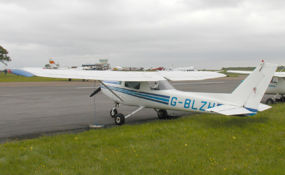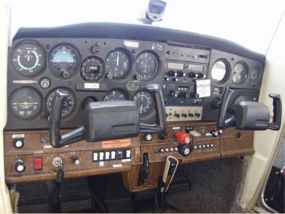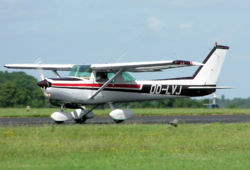PlaneSpottingWorld welcomes all new members! Please gives your ideas at the Terminal.
Cessna 152
| Cessna 152 | |
|---|---|
| Type | Multipurpose civil aircraft |
| Manufacturer | Cessna |
| Introduced | 1977 |
| Produced | 1977-1985 |
| Number built | 7,584 |
The Cessna 152 is a two-seat, fixed tricycle gear, general aviation airplane, used primarily for flight training, touring, and personal flying. First delivered in 1977 as the 1978 model year, the 152 was a modernization of the proven Cessna 150 design. The 152 was intended to compete with the new Beechcraft Skipper and Piper Tomahawk, both of which were introduced the same year.
As with the 150, the great majority of 152s were built at the Cessna factory in Wichita, Kansas. A number of aircraft were, however, built by Reims Aviation of France and given the designation F152/FA152. Production of the 152 was ended in 1985 as Cessna ended production of all of their light aircraft; by that time, a total of 7,584 examples of the 152, including A152 and FA152 Aerobat aerobatic variants, had been built worldwide.
Contents
Powerplant
All Cessna 152s were manufactured with a Lycoming O-235 engine, whereas the 150s use either Continental O-200-A in US-built versions or Rolls-Royce 0-240-A engines in the Reims produced version.
The 152 not only featured an increase in engine power over the Cessna 150, but also was more compatible with the newer 100LL low lead fuel.
Cessna 152s produced between 1977 and 1982 were equipped with Lycoming O-235-L2C engines producing 110 hp (82 kW) at 2550 RPM. This engine still suffered some lead-fouling problems in service and was succeeded in 1983 by the 108 hp O-235-N2C which featured a different piston design and a redesigned combustion chamber to reduce this problem. The N2C engine was used until 152 production ended in 1985.
Airframe
The 152's airframe is an all metal construction. It is primarily aluminium 2024-T3 alloy, although some components such as wing tips and fairings are made from fibreglass. The fuselage is a semi-monocoque structure: it has vertical bulkheads and frames joined by longerons which run the length of the fuselage. The metal skin of the aircraft is riveted, which allows loads to be spread out over the structure. The wings are of a strut-braced design and have a 1 degree dihedral angle.
Flying controls
Dual controls are available as optional equipment on the Cessna 152 and almost all 152s have this option fitted.
The Cessna 152 is equipped with differential ailerons that move through 20 degrees upwards and 15 degrees downwards. It has slotted Fowler flaps which are electrically operated and deploy to a maximum of 30 degrees. The rudder can move 23 degrees to either side and is fitted with a ground adjustable trim tab. The elevators move up through 25 degrees and down through 18 degrees. An adjustable trim tab is fitted to the righthand elevator and is controlled by a small wheel in the centre of the control console. The trim tab moves 10 degrees up and 20 degrees down.
Undercarriage
The Cessna 152 is equipped with fixed tricycle landing gear. The main gear is a tubular steel undercarriage leg surrounded by a full length fairing with a step for access to the cabin. The main gear has a 7 ft 7 in (2.3 m) wheelbase.
The nosewheel is connected to the engine mount and has an oleo strut to dampen and absorb normal operating loads. The nosewheel is steerable through 8 degrees either side of neutral and can castor under differential braking up to 30 degrees. It is connected to the rudder pedals through a spring linkage.
The braking system consists of single disc brake assemblies fitted to the main undercarriage and operated by a hydraulic system. Brakes are operated via the top portion of the rudder pedals. It is possible to use differential braking when taxiing and this allows very tight turns to be made.
The 152 is also fitted with a parking brake system. It is applied by depressing both toe brakes and then pulling the "Park Brake" lever to the pilot’s left. The toe brakes are then released but pressure is maintained in the system thereby leaving both brakes engaged.
The standard tires used are 600 X 6 on the main gear and 500 X 5 on the nose wheel.
Modifications
Taildragger conversions such as the 'Texas Taildragger' conversion are available and have been fitted to some 152s. It involves strengthening the fuselage for the undercarrige being moved further forward, removing the nosewheel and strengthening the tail area for the tailwheel. This greatly improves shortfield performance and is claimed to give up to a 10kt cruise speed increase. The wings can be modified using a number of modification kits, some improving high speed/cruise performance but most concentrating on STOL performance. Horton's STOL kit is one of the better known of the latter. It involves fitting a more cambered leading edge cuff to increase angle of attack, fitting fences at the aileron/flap intersection and fitting drooped wingtips. Stalls with these modifications are almost off the airspeed indicator. The 115hp Lycoming's power can be increased by various modifications with a 'Sparrow Hawk' power package, increasing it to 125hp.
Type Clubs
The Cessna 152 is supported by a number of aircraft type clubs, including the Cessna 150—152 Club and the Cessna Pilots Association.
Military operators
Specifications (Cessna 152)
General characteristics
- Crew: 1
- Capacity: 1 passenger (with dual controls)
- Length: 24 ft 1 in (7.3 m)
- Wingspan: 33 ft 9 in (10.3 m)
- Height: 8 ft 6 in (2.6 m)
- Wing area: 160 ft^2 (14.9 m^2)
- Empty weight: 1,100 lb (500 kg)
- Max takeoff weight: 1,670 lb (757 kg)
- Powerplant: 1× Lycoming O-235-L2C flat-4 engine, 110 hp (82 kW) driving a 69 in (175 cm), two-blade, fixed-pitch propeller
Performance
- Maximum speed: 126 mph (109 knots, 204 km/h)
- Stall speed: 49 mph (43 knots, 80 km/h) unpowered, flaps down
- Range: 477 mi (414 nm, 768 km)
- Extended range 795 mi (691 nm, 1,280 km) with long-range tanks
- Service ceiling: 14,700 ft (4,480 m)
- Takeoff roll: 725 ft (220 m)
- Rate of climb: 715 ft/min (3.6 m/s)
- Max wing loading: 10.5 lb/ft^2 (51 kg/m^2)
- Minimum power/mass: .066 hp/lb (108 W/kg)
External links
- www.cessna.com - Cessna Aircraft Company
- Aircraft Info.net - Cessna 150/152
- Cessna 150-152 Club
- Cessna Pilots Association
- AOPA Flight Training - Cessna 150/152
Related content
Related development
Comparable aircraft
- Alpha 2000 (Robin R2000)
- Beechcraft Skipper
- Grumman American AA-1
- Liberty XL2
- Piper Tomahawk
- Symphony SA-160
See also
Single-engine: 120 · 140 · 150 · 152 · 165 · 170 · 172 · 175 · 177 · 180 · 182 · 185 · 188 · 190 · 195 · 205 · 206 · 207 · 208 · 210 · 305
Twin-engine: T-50 · 303 · 310 · 320 · 336 · 337 · 340 · 401 · 402 · 404 · 406 · 411 · 414 · 421 · 425 · 441
Citation series: I-I/SP · II-II/SP-SII · III-VI-VII · V-Ultra-Encore · Excel-XLS-Sovereign · CJ/CJ1 · CJ2 · CJ3 · CJ4 · Mustang · X
Lists relating to aviation | |
|---|---|
| General | Timeline of aviation · Aircraft · Aircraft manufacturers · Aircraft engines · Aircraft engine manufacturers · Airports · Airlines |
| Military | Air forces · Aircraft weapons · Missiles · Unmanned aerial vehicles (UAVs) · Experimental aircraft |
| Notable incidents and accidents | Military aviation · Airliners · General aviation · Famous aviation-related deaths |
| Records | Flight airspeed record · Flight distance record · Flight altitude record · Flight endurance record · Most produced aircraft |
es:Cessna 152 fr:Cessna 152 nl:Cessna 152 fi:Cessna 152 sv:Cessna 152



